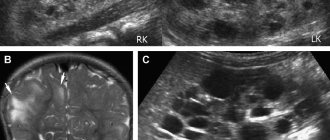The ovaries determine a woman’s reproductive ability; in addition, they are responsible for normal hormonal levels. When these organs malfunction, certain types of ovarian cysts occur in women, which, if left untreated, can cause negative consequences.
Women of reproductive age are susceptible to the formation of various types of ovarian cysts, which are characterized by certain symptoms. The formation of this pathology is associated with various reasons, on the basis of which experts distinguish types of ovarian cysts in women.
The treatment tactics for the disease depend on the type of cyst, which is determined during a comprehensive diagnosis. Patients of the Yusupov Hospital can use the services of specialists at the diagnostic center and learn about the state of their health. Oncologists at the Yusupov Hospital know how to determine the type of ovarian cyst and, based on the examination results, create an individual treatment program.
Kinds
In modern medicine, various types of ovarian cysts are distinguished depending on their origin: functional neoplasms and organic. The development of functional cysts is preceded by disturbances in the functioning of the ovaries; these neoplasms are temporary. Treatment of functional cysts is based on the use of oral hormonal medications.
The second group includes neoplasms that do not disappear within two months and require surgical intervention. Thus, ovarian cyst cystadenoma requires complex therapy and regular monitoring. Ovarian cysts classification according to structural features:
- The follicular cyst has no septa and is single-chamber. The diameter of the tumor can reach 7 cm, the cyst cavity has thin walls and a smooth surface;
- a corpus luteum cyst is characterized by thickened walls, the size of the tumor ranges from 2 to 7 cm. The walls of the cyst may be yellow and the fluid may be light;
- a hemorrhagic cyst is formed by hemorrhage of a corpus luteum or follicular cyst;
- a serous cyst of the right or left ovary is formed by epithelial cells and filled with clear liquid inside;
- an endometrioid tumor is formed when the uterine mucosa grows inward, the neoplasm is filled with blood;
- dermoid cyst is formed from embryonic germ petals and is characterized by slow growth;
- the mucinous cyst is filled with mucus-like contents and has an uneven surface;
- germ cell tumors develop most rarely. Cysts of this type are characterized by intensive development and large sizes up to 15 cm.
Oncology doctors at the Yusupov Hospital, when a patient presents with signs of an ovarian cyst, refer the woman for further examination. After which, during the consultation, they explain what types of ovarian cysts there are and determine ways to treat the existing tumor. Determining the type of tumor is an important point, allowing you to plan further treatment and select the most optimal and safe methods.
https://youtu.be/wnsMF6-fkDU
Cyst and ovarian cancer. What causes a cyst to turn into cancer?
Ovarian cysts, cancer and infectious lesions of the female genital organs are considered priority precancerous areas of modern oncology. Often for an oncologist, the terms “cystic and oncological disease” are almost identical concepts. This is due to the fact that in international classifications, cysts and ovarian neoplasms are designated as abnormal growths containing a cavity with a liquid substance.
Classification of cysts and other ovarian tumors
Despite the joint classification of these lesions, it is incorrect to say that a cyst is cancer. Gynecologists in very rare cases observe malignant degeneration of a cystic neoplasm. According to the nature of the pathological process, ovarian cysts and tumors are divided into the following groups:
- Precancerous conditions of the ovaries. Similar pathological processes occur in women over 30 years of age. Borderline cystic formations in extremely rare cases are the causes of malignant neoplasms and metastases.
- Benign tumors. Can a cyst develop into cancer? This disease is associated with endometriosis of the uterus, in which abnormal growth of the outer uterine layer occurs.
- Malignant neoplasms. Ovarian cancer is diagnosed mainly in patients who have reached menopause. In most cases, women seek medical help at stages 3-4, when the tumor causes pain. In the later stages of malignant growth, treatment includes surgery and chemotherapy. Timely radical intervention makes it possible to cure ovarian cancer in 40-50% of cancer patients.
Observation of cysts and early diagnosis of ovarian cancer
Due to the fact that a cyst can turn into cancer, patients with this pathology need to undergo thorough regular medical examination. The main method of primary diagnosis is ultrasound, which allows the gynecologist to study the size and location of the tumor.
In oncological practice, tumor marker analysis is often used to identify cysts and tumors. This technique is based on identifying specific proteins in the blood, the amount of which increases with malignant neoplasms. The most common tumor marker for ovarian pathology is CA-125. Unfortunately, this factor indicates both a cyst and cancer.
The final diagnosis is usually established based on the results of a biopsy, during which histological and cytological analysis of pathological ovarian tissue is performed.
Differential diagnosis of cyst and ovarian cancer
In the primary stages, ovarian cancer is asymptomatic. Cysts are manifested by disorders of the monthly cycle and slight pain in the lower abdomen. At this stage, the diagnosis of a malignant neoplasm occurs during a routine visit to a gynecologist.
Ovarian cysts and cancer are mainly detected in the later stages of the disease. Symptoms of a malignant tumor arise as a result of tumor growth outside the organ and the formation of secondary metastases. Signs and symptoms of cancer include: intense attacks of pain, sudden loss of body weight, chronic low-grade fever and general malaise. But at the same time, establishing a reliable diagnosis requires cytological analysis in the laboratory.
In what cases is it necessary to perform surgery in the presence of an ovarian cyst?
An ovarian cyst turns into cancer.
Only functional cysts, the occurrence of which is associated with a violation of the periodicity of the menstrual cycle and failure to ovulate, are not subject to surgical intervention. In such cases, patients are prescribed a course of conservative therapy aimed at correcting menstruation. Simultaneously with this treatment, the gynecologist constantly monitors the condition of the cyst. A functional neoplasm should normally disappear within 1-2 months. Otherwise, we are talking about a pathological cyst that requires surgery.
Radical excision of cystic tissue is necessary because the cyst can develop into cancer.
Surgery for cystic and tumor lesions of the ovaries
Surgery on the ovaries is performed under local anesthesia. During the operation, the surgeon excises the cyst. In some cases, the cystic tissue is removed along with the ovary. After radical intervention, the neoplasm undergoes histological examination to determine the final diagnosis.
This treatment is planned. In modern medicine, for surgical treatment of ovarian pathology, it is most advisable to perform laparoscopic surgery. This technique minimizes postoperative complications. In cases of cyst rupture and massive bleeding, the patient is indicated for emergency surgery.
Cystic tumor lesion of the ovary
Is it possible to save an ovary if a cyst is removed and cancer is suspected?
Preservation of the ovary during radical surgery depends on the nature of the tumor, the location of the cyst and the age of the patient.
For small cystic lesions, the surgeon performs organ-preserving surgery, in which only the cyst with capsule is excised. This intervention allows you to get rid of the symptoms of the disease and prevent relapse.
A pathological process that causes suspicion of cancer must be removed along with the affected ovary. After such an operation, the removed tissues are subjected to microscopic examination to determine the exact type of tumor.
According to statistics, if the physiological patency of the fallopian tubes is maintained, the probability of becoming pregnant with one ovary is the same as with two. In addition, in the postoperative period, women experience restoration of the menstrual cycle and ejaculation.
orake.info
Serous ovarian cyst
Ovarian cyst adenoma or serous tumor develops in women of reproductive age. When the size of the tumor is up to 3 cm, there are no symptoms of pathology, however, as the cyst grows larger, the woman’s condition worsens. The main signs of this type of cyst are aching pain in the abdomen and disruption of the functioning of nearby organs.
When treating a serous cyst at the Yusupov Hospital, surgical intervention is performed, which is the most effective method of therapy. A fibrous ovarian cyst, unlike a serous tumor, is formed by dense tissue, so its treatment is the most difficult. However, specialists at the Yusupov Hospital are developing an individual therapy program for each patient.
Symptoms and diagnosis
A benign tumor can become malignant, in such cases the main causes of complaints are weakness and dull constant pain. There is also a weight loss without any prerequisites, an increase in the size of the abdomen, and a disruption in the menstrual cycle. Malignant formations are located behind or on the side of the uterus and have a lumpy, dense structure.
Given the ability of a cyst to degenerate into a cancerous tumor, patients with benign formations should be regularly examined by specialists. The main method of initial diagnosis is the ultrasound method, which allows the doctor to determine the size and location of the tumor.
Also in oncology, the tumor marker method is used to determine cystic and malignant formations. The analysis is based on identifying specific proteins, the volume of which increases in malignant tumors.
The final stage includes a biopsy with cytological and histological analysis of ovarian tissue.
Mucinous ovarian cyst
Mucinous neoplasm progresses rapidly without treatment. Mucinous cystadenoma of the right ovary of the endocervix can grow and affect the functioning of nearby organs. The causes of tumor development are inflammatory processes, hormonal imbalances, and weak immune defenses of the body. In addition, the development of a tumor may be associated with a genetic predisposition.
A thin-walled ovarian cyst causes women to experience acute pain in the groin area, general malaise, and disruption of menstrual cycles. As the tumor spreads and compresses internal organs, urinary incontinence, constipation and bloating may occur. High-precision diagnostic equipment at the Yusupov Hospital allows specialists to identify mucinous formations and treat them at an early stage of development.
Diagnostics
It is not always possible to suspect signs of a malignant ovarian tumor.
But if a woman regularly undergoes gynecological examinations and follows all doctors’ recommendations, the likelihood that she will be diagnosed with cancer at an early stage is high.
Doctors recommend undergoing the following examinations:
- General examination in mirrors, bimanual, as well as rectovaginal examination (through the rectum). In this case, it is possible to detect damage to the parametria, tumors of at least 2 - 3 cm.
- If necessary, diagnostic curettage of the uterine cavity and cervical canal is performed, as well as puncture of the abdominal cavity through the posterior vaginal fornix. In this case, atypical cells suspicious for cancer can be identified.
- Ultrasound examination of the pelvic organs, even small formations can be detected.
- Tumor markers - proteins specific to tumors of different locations - also help in diagnosis. Their increase directly increases the risk of a malignant process. As for the ovaries, these are CA-125, HE-4, alphafetoprotein, ROMA index, beta-hCG and some others.
- Also, a doctor may suspect a tumor even after undergoing a general blood test or biochemical study.
If a neoplasm is diagnosed, the following examinations are performed to determine the extent of the process:
- X-ray of the chest organs;
- ultrasound examination of the abdominal cavity for the presence of distant metastases;
- CT or MRI;
- examination of the gastrointestinal tract - colonoscopy and FGDS;
- If enlarged lymph nodes are detected, their biopsy is performed.
Hemorrhagic ovarian cyst
A functional hemorrhagic cyst of the right ovary forms on the surface of the gonad. This tumor may be filled with blood clots or dark bloody fluid. This type of cyst is considered as a complication of the corpus luteum and luteal cyst as a result of hemorrhage in the second half of the menstrual cycle.
If a woman develops a hemorrhagic cyst of the left ovary, the oncologist chooses treatment tactics depending on the size of the tumor, the danger of the condition for the patient and the severity of symptoms. Treatment of hemorrhagic ovarian cysts is based on medications or surgery.
Symptoms of benign formations
Usually, the development of a cyst does not cause particularly negative feelings at first. Sometimes a cystic formation develops a stalk, which can become twisted during physical activity, leading to pain. Another manifestation of the occurrence of a cyst is disruption of the menstrual cycle and its painful course.
Less commonly, benign formations appear:
- sharp pain that occurs in the lower abdomen during sports activities and sexual intercourse;
- bloating, vomiting and nausea;
- frequent urination;
- high temperature (up to 39°C);
- increase in body weight.
Luteal ovarian cyst
The development of a luteal cyst is associated with disturbances in the ovulation process. A corpus luteum forms in the ovary, which resolves in the absence of pregnancy, however, as a result of pathological disorders, the corpus luteum may persist and fluid will begin to accumulate in it. In most cases, the tumor is diagnosed on only one ovary. If the cyst is small, there are no symptoms of the disease, and the tumor may resolve spontaneously.
It is important for women of reproductive age to know what kinds of ovarian cysts there are in women and what symptoms they are characterized by in order to consult a doctor in a timely manner. If left untreated, the tumor can progress and cause painful symptoms.
Can a cyst develop into cancer: the difference between a cyst and cancer
After diagnosing an ovarian cyst, almost all women are interested in: “Can a cyst develop into cancer?” Find answers to this and other questions in this article.
Neoplasm on the ovary
Types of neoplasms on the ovary
To determine whether a cyst is cancer or not, you need to know the classification of neoplasms that can appear on the ovary and, based on this, draw certain conclusions. So, there are such groups of formations:
- Benign. These include follicular cysts and small cavities that can resolve on their own over several menstrual cycles.
- Precancerous. Most often occur in women after 30 years of age. In case of neglect of the disease, incorrect diagnosis or lack of treatment, the cysts begin to degenerate and become malignant. A striking example is ovarian cystadenoma (mucinous), which can reach enormous sizes, put pressure on nearby organs and develop into a cancerous tumor.
- Malignant. The presence of malignant cells in the tumor cavity. Most often occurs during menopause. In addition, a cancerous ovary can metastasize not only to neighboring organs (intestines, bladder), but also to the chest. It cannot be treated with medication and can be removed surgically.
In modern medicine there is such a thing as cyst cancer. This means that a cystic neoplasm on the ovary can develop into an oncological disease, i.e., a cancerous formation. The appearance of cyst cancer depends on the location of the tumor, heredity, predisposition to cancer and other individual characteristics of the female body.
Unfortunately, many patients turn to the doctor already at the stage when the disease clearly makes itself felt, manifesting itself with painful symptoms. In most such cases, degeneration of the cyst is diagnosed and the woman is urgently prescribed surgical intervention.
Remember! Timely contact with a specialist and ultrasound diagnosis prevents malignancy of the cyst, and in 50% of cases makes it possible to cure the pathology with medication.
The difference between a cyst and ovarian cancer
What is the difference between a cyst and a tumor?
The table below will help you understand the differences between a cyst and ovarian cancer.
Based on the above, it cannot be said that a cyst is cancer, although it can develop into it. This happens very rarely and only in cases where the tumor is diagnosed too late or the treatment is chosen incorrectly.
Remember! The appearance of acute pain in the lower abdomen, strong red discharge, and an increase in temperature do not yet indicate the onset of malignancy! However, the woman urgently needs medical attention.
Diagnostics
A timely examination of the pelvic organs will help not only prevent malignancy of the neoplasm, but also accurately determine whether a woman has a cyst or ovarian cancer.
Since cysts can develop into tumors, women with this diagnosis should undergo regular diagnosis. Most often, specialists use the following methods to confirm/refute the disease:
- Ultrasound. Ultrasound examination makes it possible to determine the shape, size, and location of the tumor. Sometimes it is performed using a vaginal sensor.
- Blood test for tumor markers CA-125. Determines the level of specific proteins. An increase in tumor marker indicates the presence of malignant cells. There are cases when this analysis turned out to be erroneous and showed an increase in the concentration of CA-125 in a healthy woman. This is explained by the fact that the test was taken in the first days of menstruation or in the early stages of pregnancy.
- Biopsy. It is carried out by taking part of the cyst shell and/or ovarian tissue for the purpose of cytological and histological examination. The nature of the cyst and the presence of cancer cells in the contents are determined.
- Laparoscopy. Allows you to simultaneously identify the size of the cystic formation, the composition of its contents and, in case of malignancy, remove the cavity.
Initially, the doctor takes a medical history of the patient. Finds out the presence of painful symptoms in the lower abdomen, the number of births and abortions, the method of contraception used, etc. Pain in the ovarian area plays an important role. Thus, a benign neoplasm is most often accompanied by menstrual irregularities, unusual discharge in the middle of the cycle, aching and dull pain, and sometimes unilateral tingling in the right or left ovary.
Malignant formation, in turn, has pronounced symptoms: sudden sudden loss or, conversely, weight gain, asymmetry of the abdomen, increased temperature, loss of consciousness, pale skin and cold sweat.
In any case, if at least one of the above symptoms is present, a woman should contact a gynecologist as soon as possible.
Thus, answering the question: “Can an ovarian cyst develop into cancer?” It’s safe to say: “It can.” The appearance of malignant cells depends on the severity of the disease, the period of diagnosis, absence or improper treatment, age, heredity, predisposition to cancer and other individual characteristics of the woman’s body.
https://youtu.be/qaW1Fx9U6Mo
oyaichnikah.ru
Multiple ovarian cysts
Ovarian cysts can be not only single, but also multiple and diagnosed on both ovaries. A papillary ovarian cyst can grow; the formation has a pronounced capsule formed by outgrowths of the epithelium with liquid contents. With this disease, the likelihood of developing cancer increases if a woman does not receive the necessary treatment.
Specialists at the Oncology Clinic of the Yusupov Hospital have experience in treating various types of ovarian cysts. The skills and knowledge of specialists, combined with modern equipment and facilities, make it possible to effectively treat tumors, even of a malignant nature, if the patient is interested in this and follows medical recommendations.
Malignant ovarian cyst
At the diagnostic center of the Yusupov Hospital, specialists identify various types of ovarian cysts in women. In patients over the age of 30 years, borderline cysts are diagnosed, which rarely degenerate into malignant tumors. In the most advanced cases, women are diagnosed with malignant ovarian tumors, which can be cured with adequate therapy.
The serous ovarian cyst, which has an impressive size, is most susceptible to degeneration; in addition, in half of the cases, mucinous cysts degenerate in the absence of therapy. Oncologists, depending on the clinical picture, choose the most optimal methods of treating the tumor. However, with the development of a malignant tumor, most patients are indicated for surgical removal of the tumor.
Types of formations
Ovarian cyst and tumor are concepts that people often confuse. To avoid confusion, you need to understand the classification of formations that can occur on the ovary. The main options are:
- Benign. This category includes small lumps that resolve on their own with competent treatment.
- Precancerous. Such formations occur when the disease is neglected or the diagnosis is incorrect. The risk group includes women over 30 years of age. The disease is dangerous because if the lump is not detected in time, it will degenerate into cancer.
- Malignant. Formations consisting of aggressive malignant cells that can spread to other organs (metastasize). The tendency to appear is observed during menopause.
A malignant ovarian cyst differs from cancer, although it also poses a danger to the life and health of the patient, i.e. the difference is minimal.
If the woman is not helped in time, the lump will degenerate into a malignant tumor. The occurrence of the disease is purely individual in nature and depends on genetics, age, body inclination and other characteristics of the female body. In most cases, treatment involves surgery.
The ability of cystic formations to degenerate depends on their type. Follicular or luteal compactions will never develop into cancer. Also rarely, cancer occurs due to a dermoid cyst. Serous and mucinous types can often develop into cancer in the shortest possible time.
Treatment at the Yusupov Hospital
Specialists at the Yusupov Hospital provide patients with high-quality medical services that meet international standards. Treatment of ovarian cysts in women at the Yusupov multidisciplinary hospital is carried out with the participation of oncologists who regularly improve their qualifications and improve their existing skills.
During the appointment, oncologists at the Yusupov Hospital tell the patient who has been diagnosed with an ovarian cyst what types there are and what treatment is most appropriate. When developing a treatment plan, specialists choose the most gentle methods that are highly effective.
Modern medications in combination with minimally invasive techniques used at the Yusupov Hospital help preserve women’s reproductive health. If you have been diagnosed with a serous ovarian cyst or other types, make an appointment with an oncologist by calling the Yusupov Hospital.
Author
Alexey Andreevich Moiseev
Head of the Oncology Department, oncologist, chemotherapist, Ph.D.
Bibliography
- ICD-10 (International Classification of Diseases)
- Yusupov Hospital
- Cherenkov V. G. Clinical oncology. — 3rd ed. - M.: Medical book, 2010. - 434 p. — ISBN 978-5-91894-002-0.
- Shirokorad V.I., Makhson A.N., Yadykov O.A. The state of oncourological care in Moscow // Oncourology. - 2013. - No. 4. - P. 10-13.
- Volosyanko M.I. Traditional and natural methods of preventing and treating cancer, Aquarium, 1994
- John Niederhuber, James Armitage, James Doroshow, Michael Kastan, Joel Tepper Abeloff's Clinical Oncology - 5th Edition, eMEDICAL BOOKS, 2013











